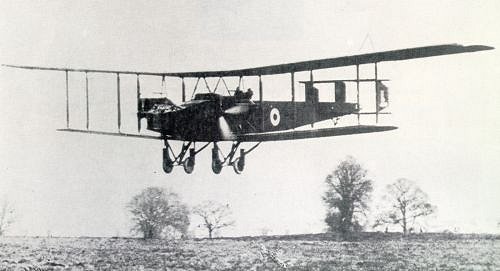207 SQUADRON ROYAL AIR FORCE HISTORY
WORLD WAR I
1917 HP O/400s
During May and June 1917, the Squadron received eight
more Handley Pages from England to replace the Short bombers.
The Squadron strength now stood at 18 aircraft, 10 in one
flight and 8 in the other. The new aircraft were O/400s, a
development of the old O/100s.

Handley Page O/400 bomber D8345 of No.7 RNAS about to land
As one of the first "all Handley-Page
squadrons", No.7 was something of a showpiece and was
frequently inspected by officers of the Allied High Command.
Early in June, the Squadron was honoured by a visit from the
King and Queen of Belgium, both of whom flew in Squadron
aircraft. Their pilot was Squadron Commander J T Babington
DSO, a new arrival on the Squadron, who was to take command
from Squadron Commander Allsop at the end of the month. (Sqn
Cdr John Babington, had been CO of RNAS Manston and was in
charge of the Handley Page Training Flight (also known as the
'Handley Page Squadron') which by the end of 1916 had been
set up at Manston to receive and prepare ex-factory HP 0/100s
for France and to train their aircrew).
In July 1917, the establishment of Handley Page squadrons
was reduced to 10 aircraft and to meet this change, the
flight of 8 aircraft was removed to the other side of the
airfield to form No.7A Squadron. It continued, however, to be
controlled by No.7 Squadron until December 1917, when it was
renumbered No.14 Squadron RNAS (later No.214 Squadron RAF)
and became an independent unit.
On 31 July 1917, the Battle of Ypres commenced and from
then until mid-November, when the battle ended, the Allies
waged a vigorous and unremitting air offensive in support of
the Army. The RNAS squadrons, including Nos.7 and 7a, kept up
constant day and night attacks on enemy airfields and coastal
targets. They also bombed railway stations, junctions and
depots in an attempt to isolate the battlefield. This was one
of the earliest examples of the use of aircraft in the
interdiction role. On the night of 16 August, Nos.7 and 7a
Squadrons made their most successful night attack. In support
of the British Army's attack at Lanemarck, they raided the
Thourout railway junction and ammunition dumps with 14
aircraft, all of which found and bombed the target. Nine tons
of bombs were dropped, ranging from 65 to 250 pounds.
Explosions were still taking place 90 minutes after the last
aircraft left the target area and the fires were visible from
behind the British trenches.
During this autumn of 1917, the Flanders RNAS Command
reached the peak of its bombing power. Attacks such as the
one on Thourout became commonplace and the tonnage of bombs
increased to an average of 6 tons per raid during September.
Between the nights of 2 and 4 September, Nos. 7 and 7a
Squadrons dropped over 16 tons of bombs on the Bruges docks
alone. The amount of destruction achieved by these raids is
perhaps best shown by the importance attached by the German
High Command to the elimination of the Dunkirk Command.
From September, the towns and airfields of the Dunkirk
Command were subjected to nightly attacks from land, sea and
air. So intense were these attacks that the RNAS Aircraft
Depot was forced to decentralise into a series of sub-depots
and parks. Severe though these raids were, they completely
failed in their main aim of curtailing Allied bombing. Not
only did Allied bombing increase but the scope of targets was
widened.
A good example of this fortitude was the attempted attack
on Cologne by a single aircraft of No.7 Squadron on 20
October 1917. Piloted by Flight Sub-Lieutenant R G G Gardner,
this aircraft encountered extremely bad weather about halfway
to the target and was forced down to 2,500 feet. At Duren,
some 20 miles from Cologne, the aircraft was down to 2,000
feet and the bad weather was worsening steadily with cloud
and heavy rain. Just then the crew sighted a well-lit factory
3 miles east of Duren and Gardner decided to attack it
instead of finding Cologne. Twelve 112 pound bombs were
dropped and eleven fell within the factory walls, the twelfth
falling in the road outside. The homeward journey was made
under even worse weather conditions and for two and a half
hours the crew were unable to see the ground at all. They
crossed the trenches at 2,000 feet, under heavy fire from the
ground, and finally landed successfully on Droelandt
aerodrome, despite its small size and the complete absence of
landing lights. By the time they landed the crew had been in
the air for seven and a half hours and had covered some 400
miles, over mainly unknown territory.
From November 1917 until February 1918, very few sorties
were flown because of unfavourable weather and bad airfield
conditions. Squadron Commander Babington was succeeded by
Squadron Commander H A Buss on 1 January 1918 but he too was
posted shortly afterwards and was replaced by Squadron
Commander H Stanley-Adams DSC on 20 February 1918.
Returning from a night attack on 18 February 1918, Flight
Lieutenant E R Barker achieved the rare Bomber distinction of
shooting down an enemy fighter. The attacking aircraft was an
Albatross D5 Scout, a formidable fighter, but Barker's
observer, Flight Sub-Lieutenant F H Hudson calmly waited
until the German Scout was about 20 feet below and 50 feet
ahead of him, having completed its first pass, and then fired
a burst from the front gun into the enemy's front fuselage.
The Scout appeared to stall and, after a second burst,
nose-dived apparently out of control.
